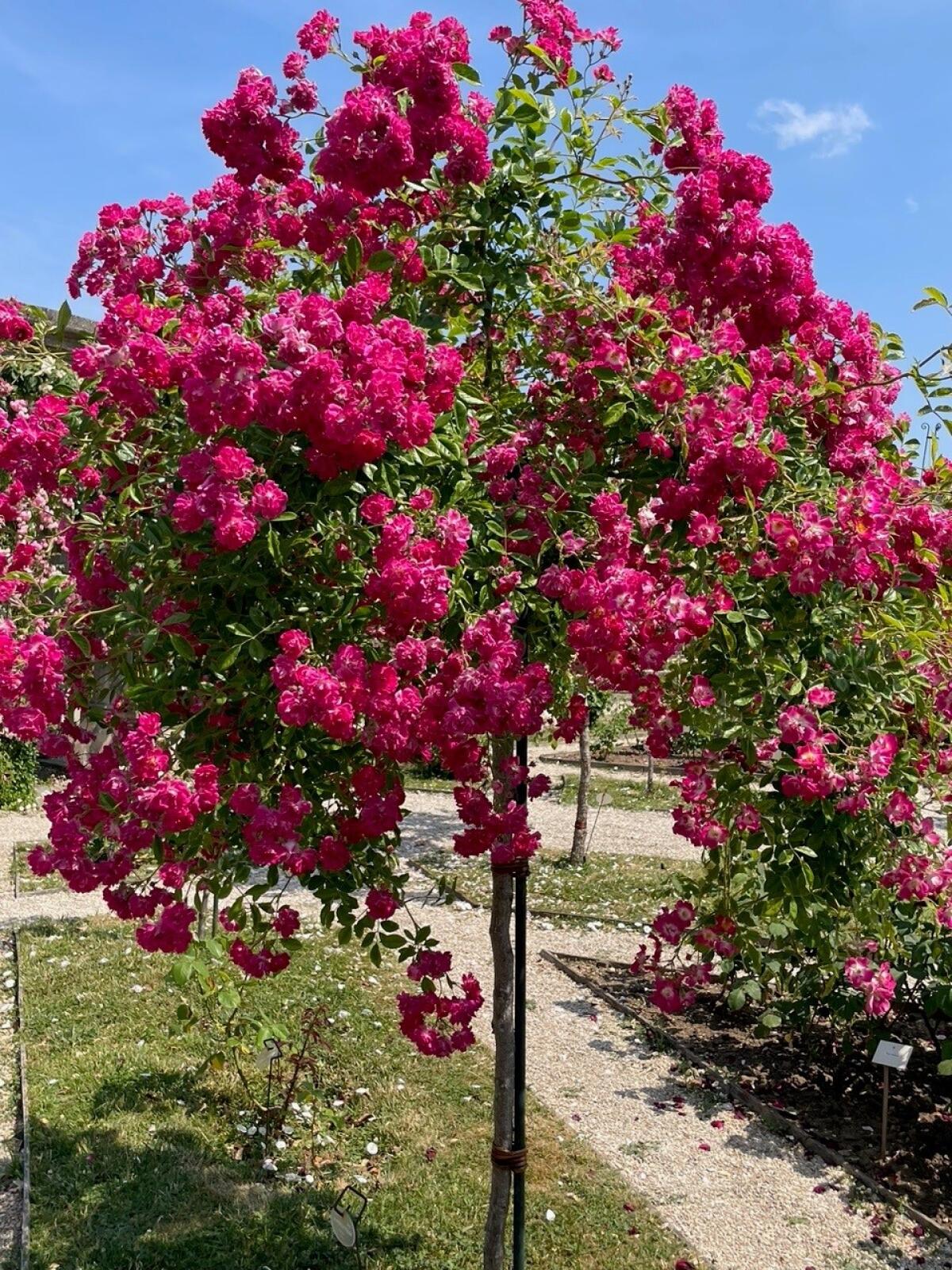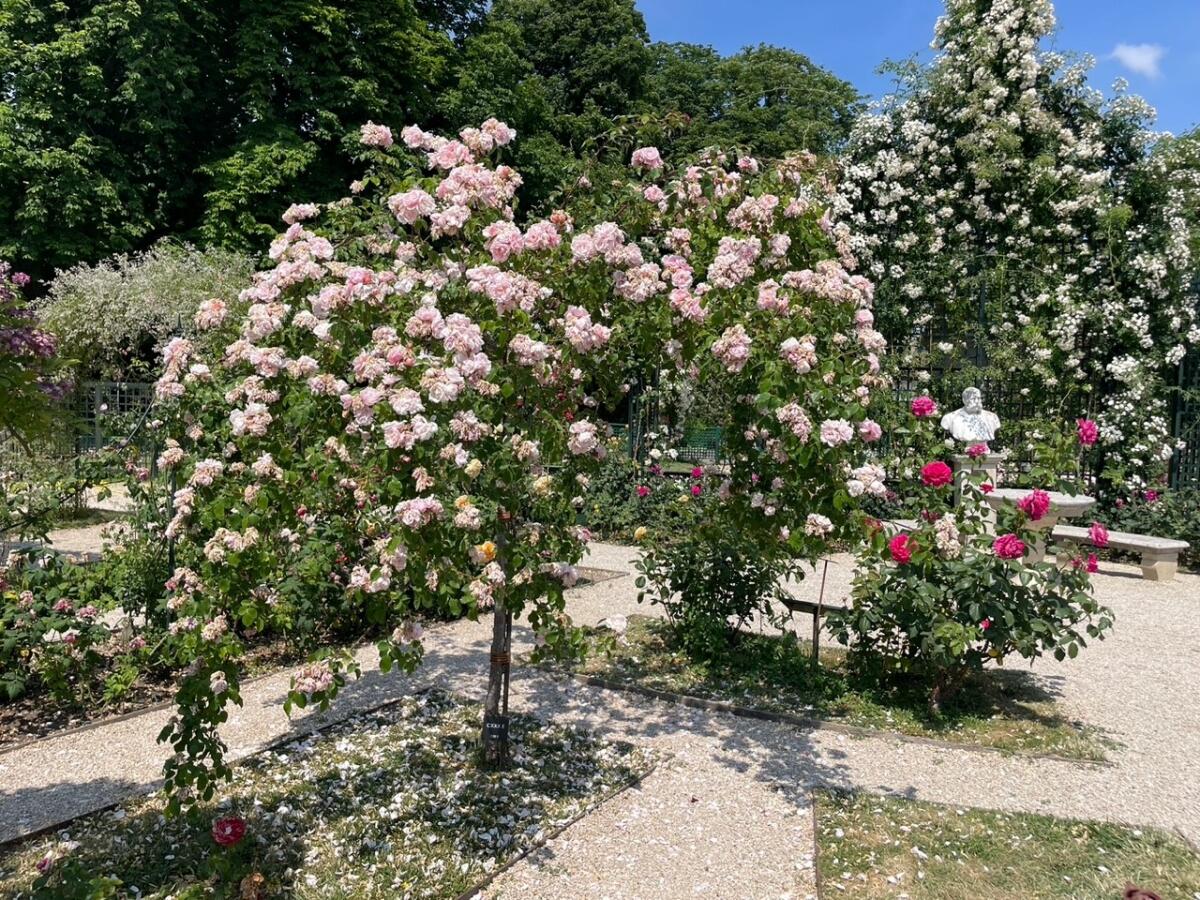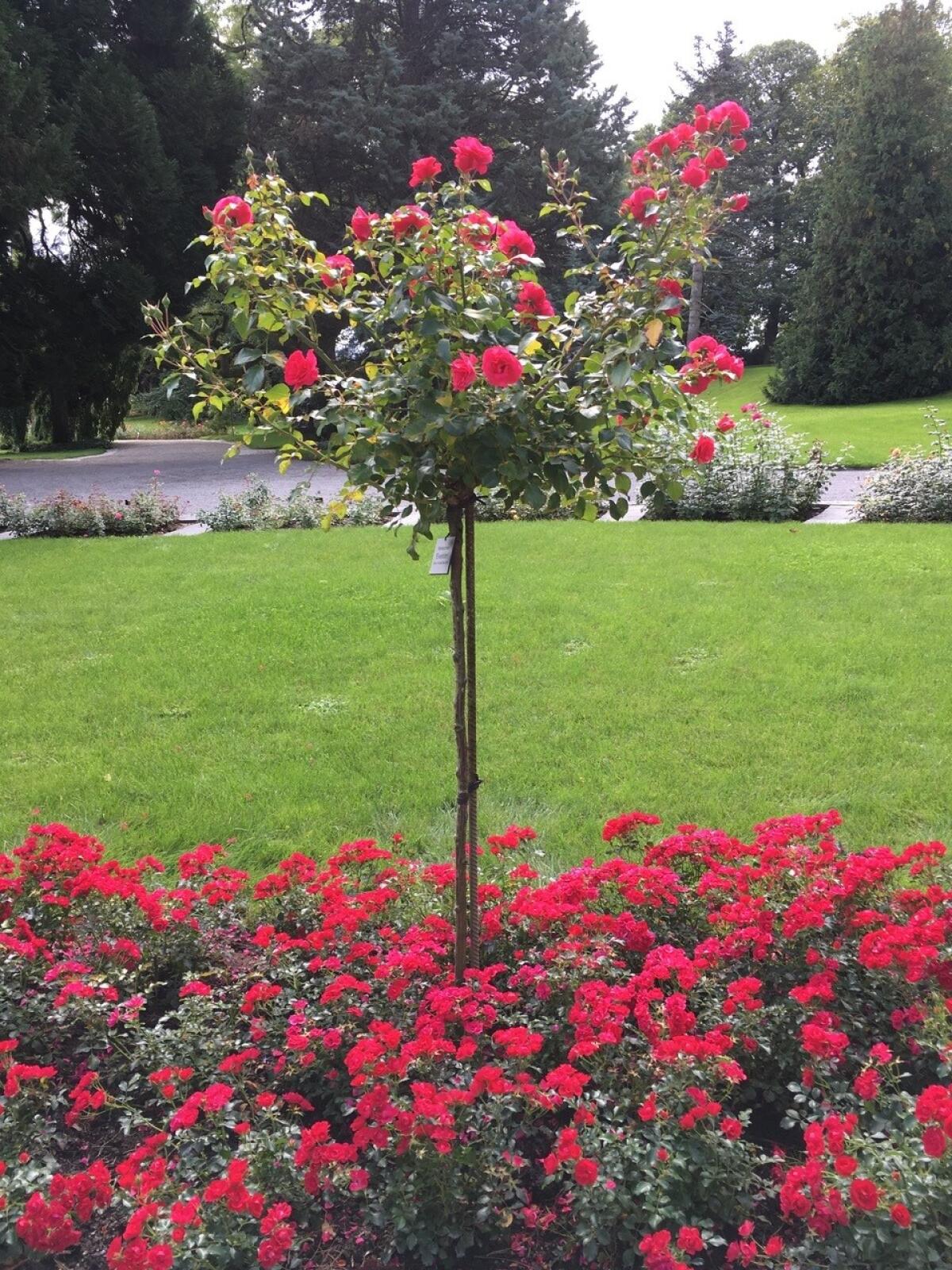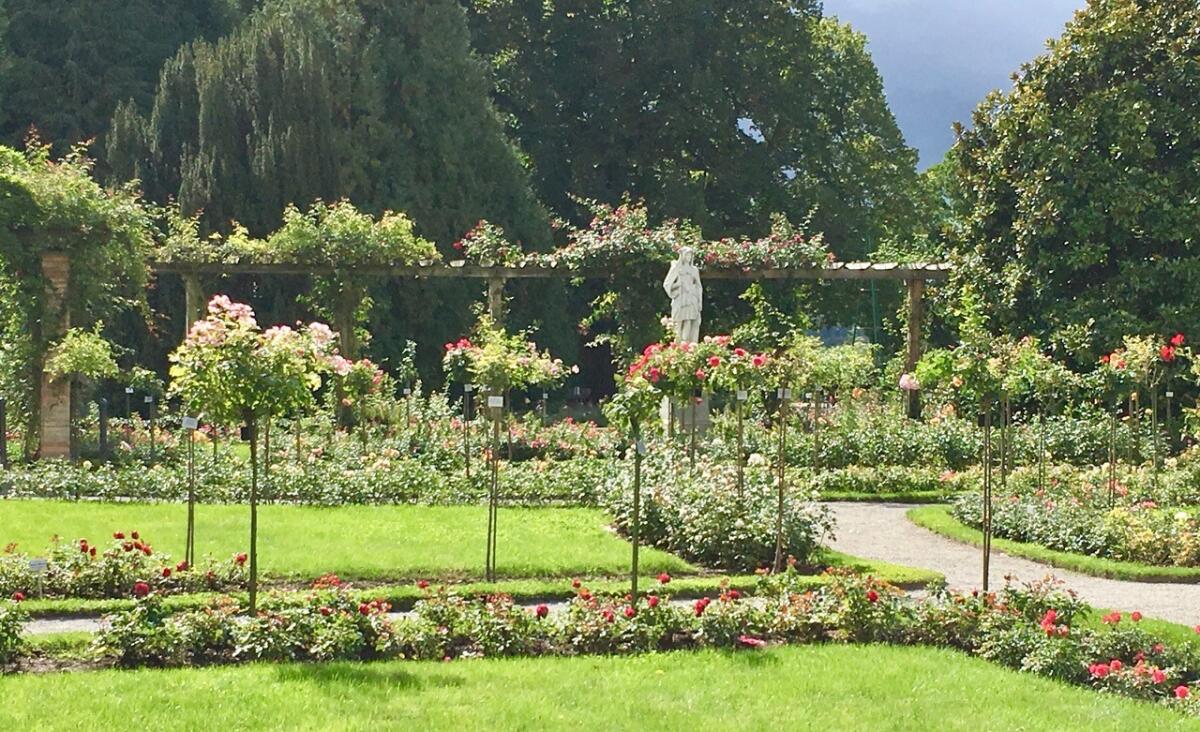Gardening is an activity that really helps us to relieve stress, but it is not free of challenges. I am embarrassed to confess that I have had two unfortunate mishaps with tree roses. More accurately, the unfortunate (now demised) tree roses had mishaps with me.
Botanically speaking, roses are erect, climbing or trailing shrubs. Roses that have trunks and look like trees are called “tree roses” or “standards.” They are not a separate category of rose. Rather, they are a description of the form of a rose, which is a completely manmade plant.
The components of a tree rose
A tree rose consists of three separate plants that are grafted together. A hardy, robust rootstock such as ‘Dr. Huey’ is grafted to a stem. The stem can also be ‘Dr. Huey,’ but stems are also taken from R. multiflora or R. canina. The result is a sturdy tree trunk, to which is grafted the scion, the upper part of the desired flowering variety. Different heights of tree roses are available to suit your purpose. Miniature roses are generally grafted to 18-inch trunks and are often called patio tree roses. Floribundas, grandifloras and hybrid tea roses are grafted to trunks that are 24, 36 or 48 inches tall.

A rambling rose with clusters of magenta-pink roses, ‘Super Excelsia’ is grown at the Roseraie de l’Hay, a rose garden outside Paris, as a tree rose. Note the sturdy rebar stake.
(Rita Perwich)
From start to finish, the process of creating a tree rose usually takes about five years. For the first two years, the roots, stems and scion are typically grown separately. Then, in the third year, the plant is grafted together.
Growers bud two or three scions of a rose cultivar onto the tree trunk to create a bushy, full flowering head on top of the tree. Sometimes growers will bud two varieties on one trunk. This can be effective, provided the varieties are well matched in vigor and are color compatible. The plant is grown for another year before being dug up during bare root season and sold as a bare root plant at the nursery.
Garden use
Tree roses have a lot of versatility in a garden, adding height, color and visibility to a garden bed and providing fragrance at nose level. They are charming when planted along the pathway to your home’s entry and can act as beautiful accents to frame each side of an archway. These roses are perfect for planting in a narrow space that needs some vertical interest. In the right placement, a tree rose can add a unique touch to your garden.

‘Blush Rambler,’ a vigorous rambler classified also as a polyantha, blooms in stunning, large clusters, and has a lovely cascading form when grown as a standard at Roseraie de l’Hay, a rose garden outside Paris.
(Rita Perwich)
- When purchasing your rose, look to see that it is in fact double or triple budded and growing well from each bud. This is especially easy to observe when the plants are bare root. When buying your rose, examine the entire trunk for any damage. Selecting a sturdy trunk is important, because the trunk will be exposed to sun and wind damage and needs to be strong enough not to snap or break in the wind. The trunk also needs to support the full weight of the rose canes and blooms. Look for four to six strong healthy canes, preferably positioned evenly around the crown. If the bare root tree rose is not potted up, you can also inspect the roots to make sure they are not damaged. Expect to pay more for tree roses. They range from approximately $40 to over $50 depending on their height.
-
Any variety of rose can be made into a tree, but some rose varieties look better than others. You want a rose that has an ever-blooming, lush and bushy habit. This is why we often see ‘Iceberg’ as a standard, because it flowers abundantly and does repeat bloom very often. The general consensus is that roses that produce a multitude of blooms on short stems, like floribundas, polyanthas and shrub roses, are more attractive as a tree rose than are hybrid teas.
For example, the floribundas ‘Sexy Rexy,’ ‘Julia Child’ and ‘Angel Face’ and many David Austin roses are stunning in tree rose form. ‘The Fairy,’ which is a compact short dainty polyantha with an Earth-Kind designation, is fantastic when grafted as a tree rose. Its abundant wealth of tiny pink pompon sprays gets elevated from its usual 2- to 3-foot height to eye level.

‘Elveshörn’ is a Kordes shrub rose. Here it is planted with an underplanting of red groundcover roses in the formal rose garden at the Isle of Mainau. Note its sturdy rebar stake.
(Rita Perwich)
Tree roses that have a climbing rose such as ‘Albertine,’ ‘Veilchenblau,’ ‘Blush Rambler’ and ‘Albéric Barbier’ as the scion, are exceptionally beautiful as they display a waterfall or weeping or cascading form. These larger roses are often grafted to a 5- or 6-foot trunk for a grand effect. ‘Climbing China Doll’ as a tree rose is unforgettably striking. I saw a photograph of this rose years ago and I am still in the hunt for one I can call my own.
Care for your tree rose
Pruning: To allay intimidation of pruning, I invariably tell new rosarians at pruning workshops that there is very little they can do to harm the rose. I usually get a few laughs when I add, “so long as you don’t prune under the bud union.” Because seriously, who would do that?
Certain things in life keep us humble. For me, one of these things is the tree rose. The very first rose I ever pruned many, many years ago was a tree rose. I couldn’t get it “sufficiently tidy,” so I decided to allow it to get a nice fresh new start.
I had a niggling feeling when I cut off all the canes under the bud union and left just the stem that I had gone a little too far. The grafted rose with all its canes and blooms was forever gone. All that was left of the plant was its roots and a headless trunk.

Tree roses bring formality and vertical beauty to the rose garden in the Isle of Mainau.
(Rita Perwich)
On a positive note, the experience encouraged me to attend a pruning workshop. I learned how to prune, and I also learned that tree roses are pruned on the same principles as shrub and floribunda roses. We cut out dead, damaged and crossing canes. Cuts are made at an outward-facing bud eye.
In San Diego, we do not prune severely and generally take only one-quarter to one-third off the length of the canes. We never, EVER cut below the bud union on any grafted rose, including tree roses.
Care: Plant your tree rose at the same depth it was growing in the container and fertilize and care for your tree rose the same as all of your other roses. Tree roses may need extra water. Do keep an eye out for suckers coming from the rootstock or the trunk and remove them forcibly by wrenching them out to prevent the sucker from taking over and sapping energy from your tree rose. Deadhead the blooms regularly, which also gives you an opportunity to shape the rose. Tree roses can be grown very successfully in containers.
Tree roses must be staked
The second lesson I learned from tree roses is the necessity of staking. Canes are elevated on a slender trunk that can snap or break, and the entire plant can even blow over in very windy conditions. Also, an unstaked rose can start to grow at an angle. My ‘Julia Child’ tree rose was planted close to a plumeria. As the plumeria grew larger and taller, the rose tilted and then kept tilting in a valiant attempt to capture its fair share of sunlight. Over the course of a few years, the rose lost its attractive vertical posture and grew at an awkward 45-degree angle.

‘Alberic Barbier,’ a robust and fragrant rambling rose that was hybridized in 1900, displays a beautiful weeping form when grown as a tree rose.
(Rita Perwich)
To keep tree roses sturdy and upright, position a rebar or galvanized pipe in the hole, preferably before planting the rose. If you use wood stakes, you will need to be replace them every few years. Sink your stake a foot into the ground and extend it at least a few inches above the graft union. Secure the stake to the stem using a flexible material like plastic tape, and check frequently to ensure the stem is not being constricted.
Tree roses can be used to great effect in the garden. ‘Weeping China Doll’ as a tree rose remains etched in my memory. This is not unusual, because when you encounter a fabulous tree rose, you won’t forget it. It will take the stage and act like royalty.
Perwich is a member of the San Diego Rose Society, a consulting rosarian and a master gardener with UC Cooperative Extension.



